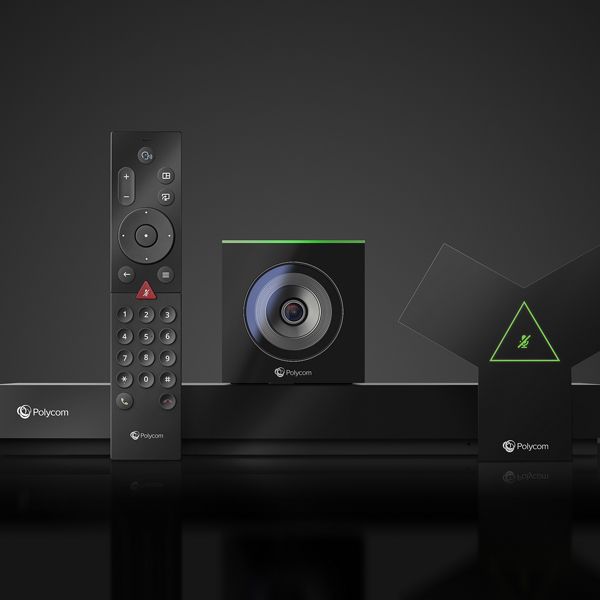Polycom G7500

Aside from equipment installation, two significant elements of audiovisual are wiring and system control. If either of these components are faulty or missing, the system may not demonstrate optimal performance.
Wiring is a skill that not only requires proper cable rating selection based on a number of factors, including distance to the main rack, frequency and fire codes,
but wires should also be out of sight, behind the walls and in the ceiling, when possible. System performance also depends on the integrity of the wires. If wires become exposed or mishandled during cabling, the signals may not transmit fluidly, which could compromise the quality. Wires should be neatly organized into the main component and properly labeled for easy reference.
Polycom G7500

Control refers to how the system will operate and how all the installed components will communicate. System automation devices from manufacturers like RTI, Crestron, Control4, AMX, Lightware and others are programmed to integrate the various components of the system and makes the system easy to use from various devices. For example, when programmed appropriately, a control system can allow a TV in zone one to automatically turn off when the music in zone two is turned on. Without proper control programming, the TV in zone one would stay on, even when the music in zone two is turned on.
Polycom G7500

The professional audiovisual industry is a multibillion-dollar industry, comprising manufacturers, dealers, systems integrators, consultants, programmers, presentations professionals, and technology managers of audiovisual products and services.
Commercial audiovisual can be a lengthy process to install and configure correctly. Boardroom audiovisuals can be installed for a number of reasons and often is due to the executives of the organization or business needing to have meetings with colleagues, customers and suppliers around the world. When creating an array of boardrooms for customers it beneficial to balance the pattern from the audio and microphone so there is no degradation in sound quality for the individuals listening.[5]
The proliferation of audiovisual communications technologies, including sound, video, lighting, display, and projection systems is evident in many sectors of society.

This includes business, education, government, the military, healthcare, retail environments, worship, sports and entertainment, hospitality, restaurants, and museums. The application of audiovisual systems can be found in collaborative conferencing (which includes video-conferencing, audio-conferencing, web-conferencing, and data-conferencing), presentation rooms, auditoriums and lecture halls, command and control centers, digital signage, and more. Concerts and corporate events are among the most obvious venues where audiovisual equipment is used in a staged environment. Providers of this type of service are known as rental and staging companies, although they may also be served by an in-house technology team (e.g., in a hotel or conference center).
Polycom G7500

Polycom G7500 | Polycom Video Conferencing

Polycom G7500
Meet the Polycom G7500, help teams share ideas and express themselves clearly—in Ultra HD 4K. No ideas get left behind, because anyone can share wirelessly, annotate and capture content for later use. With detailed visuals and rich audio, people feel like they’re together in the same room. With noise cancellation built-in, audio distractions like background noise and side conversations are a thing of the past. G7500 is deployment friendly too, with an intuitive user interface and flexible set-up that increases adoption and utilization. The G7500 runs cloud service applications natively or the Poly Video app for standards-based calling and connection into any provider or video system.
- Premium audio quality and voice clarity
- Share content wirelessly from any device
- Content annotation and digital whiteboarding
- Customization and security for room control using REST APIs
Poly G7500 Highlights
- Simplify the user experience by combining video conferencing and content sharing in one solution.
- Make people feel like they are together in the same room with Ultra HD 4K for amazing richness and clarity when sharing content
- Minimize background noise from disrupting meetings with advanced audio technology including NoiseBlockAI
- Native support for popular cloud services eliminating the need for a PC or Mac

Polycom G7500 Specifications
Content Sharing
- Poly Content App support
- Apple Airplay
- Miracast
- HDMI input
Video Standards & Protocols
- H.264 AVC, H.264 High Profile, H.264 SVC, H.265, RTV
- H.239
- H.264 video error concealment
Audio Standards & Protocols
- 22 kHz bandwidth with Polycom Siren 22 technology, G.719 (M- Mode)
- 14 kHz bandwidth with Polycom Siren 14 technology, G.722.1 Annex C
- 7 kHz bandwidth with G.722, G.722.1
- 3.4 kHz bandwidth with G.711, G.728, G.729A